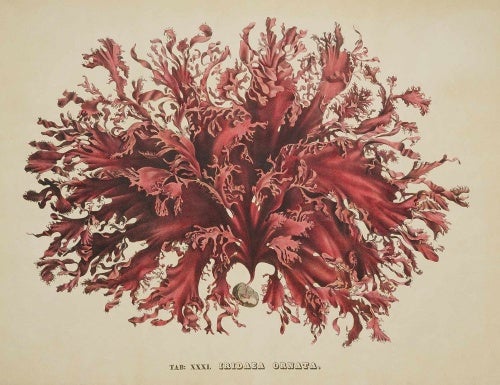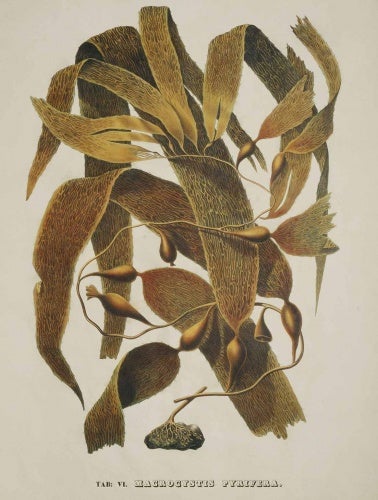
Aleksandr Postels' illustration of the seaweed species Iridaea Ornata

Macrocystis Pyrifera (a species of giant sea kelp) from Illustrationes algarum
As part of its "From the USC Libraries" feature, the Chronicle showcased Aleksandr Postels' vivid drawings of seaweed and giant kelp from a 1826-29 voyage along the coasts of Russian territories in Asia and the present-day American Pacific Northwest.
Illustrationes algarum in itinere circa orbem jussu Imperatoriis Nicolai I.
By Dan Knapp
In August 1826, the Russian vessel Seniavin set sail from Kronstadt and began a three-year survey of the coasts of Asia and North America’s Pacific Northwest.
Outfitted with a Russian Navy crew and a team of scientists from the St. Petersburg Imperial Academy of Sciences, the expedition’s directive from Czar Nikolas I was the discovery and collection of scientific data.
On board, scientists such as naturalist Franz Karl Mertens, mineralogist Aleksandr Postels, and ornithologist Friedrich von Kittlitz collected thousands of specimens relating to the fields of oceanography, botany, phycology, zoology and geology.
Postels, a gifted artist, illustrated more than 100 different types of Northern Pacific plant life during the round-the-world odyssey. Upon his return to Russia, Postels worked with botanist Franz Joseph Ruprecht to describe the marine algae and seaweed depicted in his hand-colored lithographs.
In 1840, the duo published their double-elephant folio, Illustrationes algarum in itinere circa orbem jussu Imperatoriis Nicolai I.
Printed in Russian and Latin, the book contains 40 of Postels’ artistic renderings and is considered a landmark achievement in documenting the never-before-seen marine plant life.
The plant genera Postelsia and Ruprechtia are named, respectively, in the authors’ honor.
In the mid-1940s, the Allan Hancock Foundation—funded by Captain G. Allan Hancock—purchased the collection of books and journals of the Boston Society of Natural History that became the foundation of USC’s Hancock Natural History Collection; Illustrationes algarum was among the items acquired through the sale.
The Hancock Natural History Collection is comprised of more than 78,000 volumes of books and periodicals published between 1525 and 1944. Among the collection’s most notable holdings are Pierre Joseph Redouté’s Les Liliacées (1813), Description de L’Égypte (1809-28), John James Audubon’s The Birds of America (1827-38) and a first American edition of Charles Darwin’s On the Origin of Species by Means of Natural Selection (1860).
To learn more about the Illustrationes algarum or the Hancock Natural History Collection, call 213-740-5900 or e-mail specol@usc.edu.